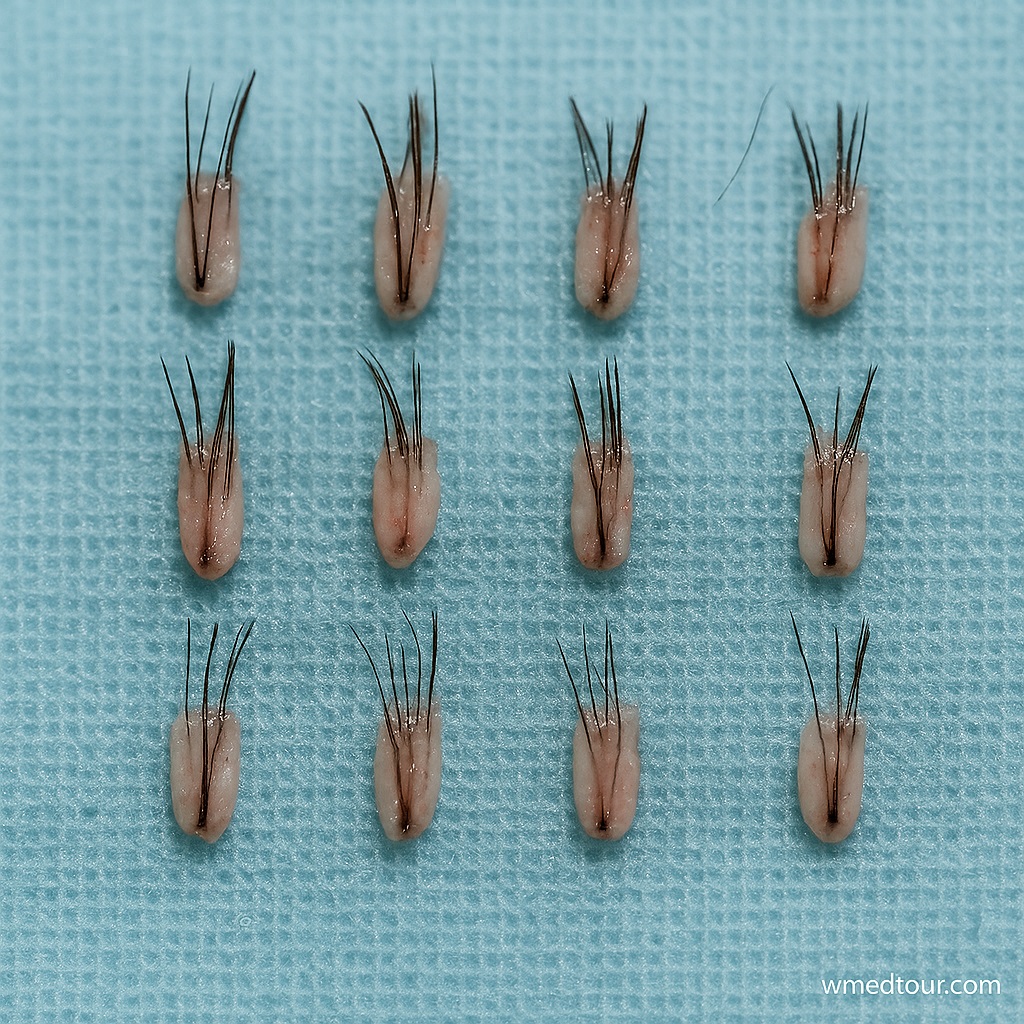Hair Transplant: How Many Grafts Do You Need? The Definitive Guide
If you’re considering a hair transplant, one of the first and most critical questions you’ll have is, “How many grafts do I need?” It’s a simple question with a complex answer, as the number of grafts required is highly personal and depends on a variety of factors. The number isn’t just a random figure; it’s a precise calculation that a skilled surgeon uses to create a natural, dense, and aesthetically pleasing result. Getting this number right is the cornerstone of a successful hair transplant.
In this comprehensive guide, we’ll break down everything you need to know about graft count. We’ll explore what a graft is, the key factors that influence the number you need, and provide a general breakdown based on the Norwood and Ludwig scales. Ultimately, we’ll show you why a detailed, in-person or virtual consultation is the only way to get a truly accurate estimate.
Understanding the Basics: What Exactly is a Hair Graft?
Before we talk about numbers, let’s clarify the term “graft.” A follicular graft (or follicular unit) is the naturally occurring grouping of hair follicles on your scalp. These clusters can contain anywhere from 1 to 5 hairs, but most commonly they contain 2 or 3. When a surgeon performs a Follicular Unit Extraction (FUE) or Follicular Unit Transplantation (FUT), they are harvesting these entire grafts, not individual hairs. This is why a graft count is a more accurate measure than a hair count—a single graft can contain multiple hairs, leading to a much higher total hair count than the number of grafts transplanted.
For example, if a clinic claims to transplant 3,000 grafts, this can mean they are actually implanting 6,000 to 9,000 individual hairs, depending on the average number of hairs per graft. This is a critical distinction to remember when researching clinics and comparing prices. To learn more about the different methods, check out our guide on the best hair transplant methods.
Key Factors That Influence Your Graft Count
The number of grafts you need isn’t pulled from thin air. It’s the result of a careful assessment of several key variables. An ethical and experienced surgeon will take all of these into account during your consultation to provide a realistic and effective treatment plan.
1. The Extent of Your Hair Loss
This is the most obvious and important factor. The larger the area of baldness or thinning, the more grafts will be required to cover it. Doctors use standardized scales to classify the degree of hair loss. For men, the Norwood Classification System is the most widely used tool, while for women, the Ludwig Classification System is often used. We will delve into these scales in more detail below, but for now, understand that a person with a Norwood 2 will need far fewer grafts than someone with a Norwood 6.
2. Your Desired Density
Density refers to the number of hairs per square centimeter. A natural-looking result requires a certain density, but this can vary depending on your goals. Some people are happy with a slightly lower density for a fuller overall appearance, while others want a very dense, thick result. The higher the desired density, the more grafts will be needed. Achieving high density is now more possible than ever thanks to modern techniques like Direct Hair Implantation (DHI) and Sapphire FUE. Read our guide on achieving natural restoration to see how density plays a role.
3. The Quality and Quantity of Your Donor Hair
Your donor area, usually the back of your head, is the source of the transplanted grafts. The quality of this hair (its thickness, texture, and curl) and the density of the follicles within this area are crucial. If you have a high density of grafts in your donor area, more can be safely harvested without causing a noticeable thinning. Conversely, if your donor area is weak, you may be limited in the number of grafts that can be extracted in a single session. This is why it’s so important to be a good candidate for a hair transplant. Check out our definitive checklist to see if you’re a good candidate.
4. Hair and Skin Characteristics
Certain hair characteristics can affect the final result and the number of grafts. For example, people with thick, coarse, or curly hair often require fewer grafts to achieve a full appearance than those with fine, straight hair. The texture and color of your hair relative to your skin tone can also create the illusion of greater or less density. A good surgeon will consider all of these nuances to plan the perfect procedure.
Graft Count by Norwood and Ludwig Scale (A General Guideline)
To give you a better idea of what to expect, here is a general breakdown of estimated graft counts based on the common classification scales. Please remember, these are just estimates and your specific needs will be determined by a specialist.
Norwood Scale for Men
| Norwood Stage | Description | Estimated Grafts |
|---|---|---|
| Stage 1-2 | Minimal or no hair loss, typically a slightly receding hairline. | 500 – 1,000 grafts (often for hairline refinement). |
| Stage 3 | Significant recession in the temples (classic ‘M’ shape). | 1,500 – 2,500 grafts. |
| Stage 4 | Recession at the temples and a sparse or bald spot on the crown. | 2,500 – 3,500 grafts. |
| Stage 5 | The bridge of hair between the temples and crown is very thin. | 3,500 – 5,000 grafts. |
| Stage 6-7 | The most advanced stages, with a large bald area and a narrow band of hair remaining on the sides and back. | 4,000+ grafts, often requiring a second session or mega-session. |
Ludwig Scale for Women
| Ludwig Stage | Description | Estimated Grafts |
|---|---|---|
| Stage I | Mild hair loss, primarily at the central part. | 800 – 1,500 grafts. |
| Stage II | Moderate hair loss with noticeable widening of the part. | 1,500 – 2,500 grafts. |
| Stage III | Extensive hair loss with a transparent or bald scalp on the crown. | 2,500 – 3,500+ grafts. |
As you can see, the number of grafts can vary widely. This is why a one-size-fits-all approach is not effective. A personalized consultation is essential to determine your specific needs and ensure a successful outcome.
Mega-Sessions vs. Multiple Sessions
For individuals with extensive hair loss (Norwood 5-7), surgeons may recommend a “mega-session,” which involves transplanting a very large number of grafts (4,000 or more) in a single, long session. While this can provide a dramatic result in one go, it also puts more stress on the donor area. Alternatively, a surgeon may recommend multiple sessions spaced a year or so apart. The latter is often a safer approach, allowing the donor area to fully recover and the transplanted hair to grow in before the next procedure. Modern techniques and tools make these large sessions safer and more efficient. Learn more about the latest innovations in hair transplantation.
How to Get a Precise Graft Count: The Role of a Professional Consultation
The most crucial step in this process is a thorough consultation with a qualified hair transplant surgeon. During this meeting, a specialist will use their expertise to:
- Analyze Your Hair Loss: They will use a trichoscope or other magnifying tools to accurately measure the extent of your hair loss and evaluate the density and quality of your donor hair.
- Discuss Your Goals: Your surgeon will talk to you about your desired outcome—do you want a slight improvement or a significant change? This helps them manage expectations and plan the procedure effectively.
- Assess Donor Capacity: They will ensure your donor area has enough healthy grafts to meet your goals without being over-harvested. Over-harvesting can lead to a thinned-out look in the donor area, which is undesirable.
- Create a Custom Plan: Based on all these factors, your surgeon will create a detailed plan, specifying the exact number of grafts needed and the strategy for their placement to achieve a natural, permanent result.
A good surgeon will be honest about what is achievable and what is not. They should explain the entire process, including the cost, the recovery timeline, and what to expect during each stage. Learn more about the cost of a hair transplant here.
Conclusion: It’s All About the Plan, Not Just the Number
The number of grafts is a critical piece of the puzzle, but it is just one part of a successful hair transplant. The true art and science of hair restoration lie in the surgeon’s ability to create a plan that perfectly matches your individual needs with the available resources. This ensures that the transplanted hair not only grows but also looks incredibly natural and lasts a lifetime. Whether you need 1,000 grafts or 5,000, the most important thing is to work with an experienced professional who understands the nuances of modern hair restoration. At Wmedtour, we connect you with world-class surgeons who prioritize precision, artistry, and, most importantly, your long-term satisfaction. Find out how to choose the best surgeon abroad.
Get a personalized graft estimate today.
Frequently Asked Questions About Hair Transplant Grafts
Here are some of the most common questions we hear about hair grafts and the number of grafts needed.




